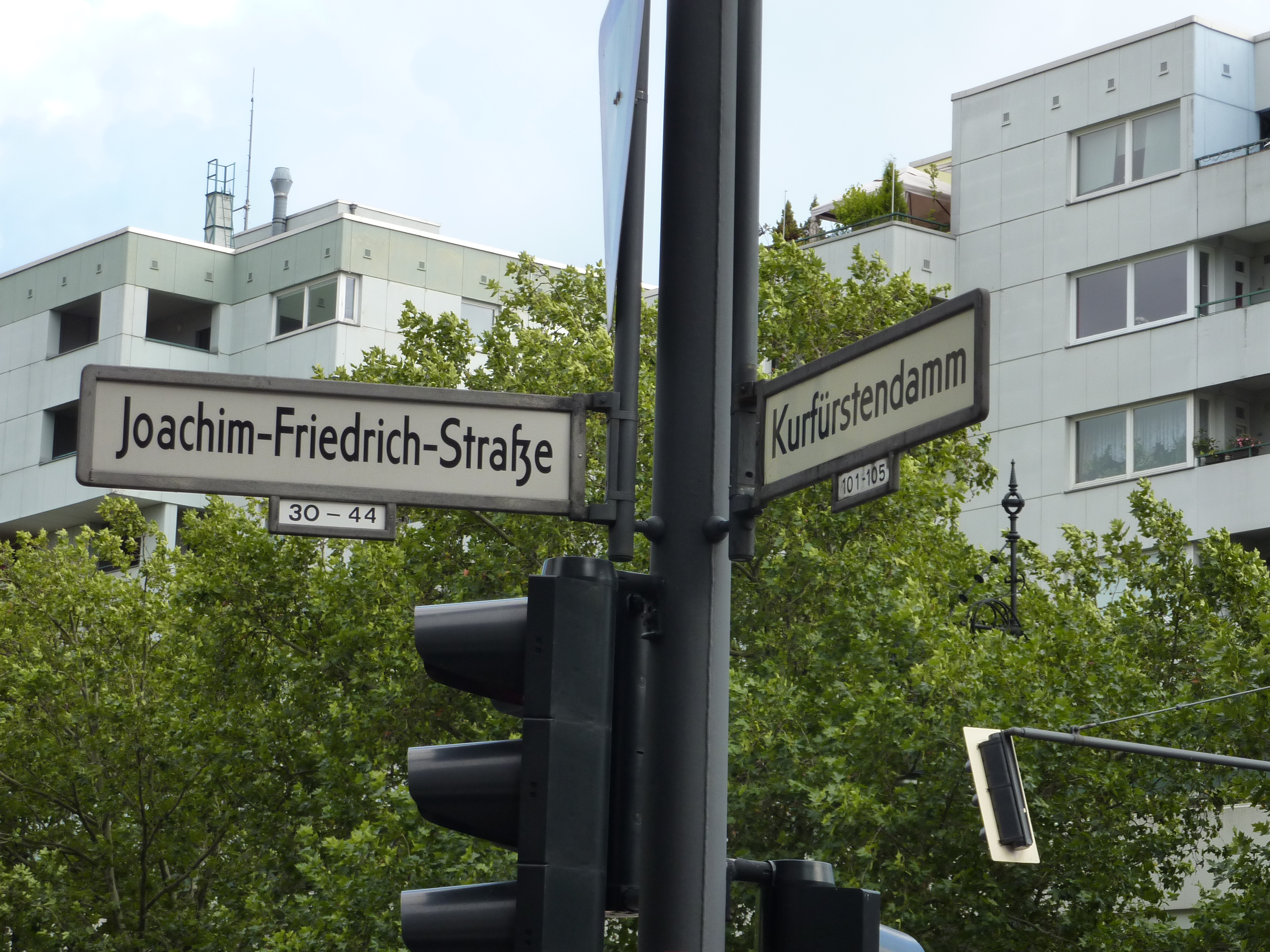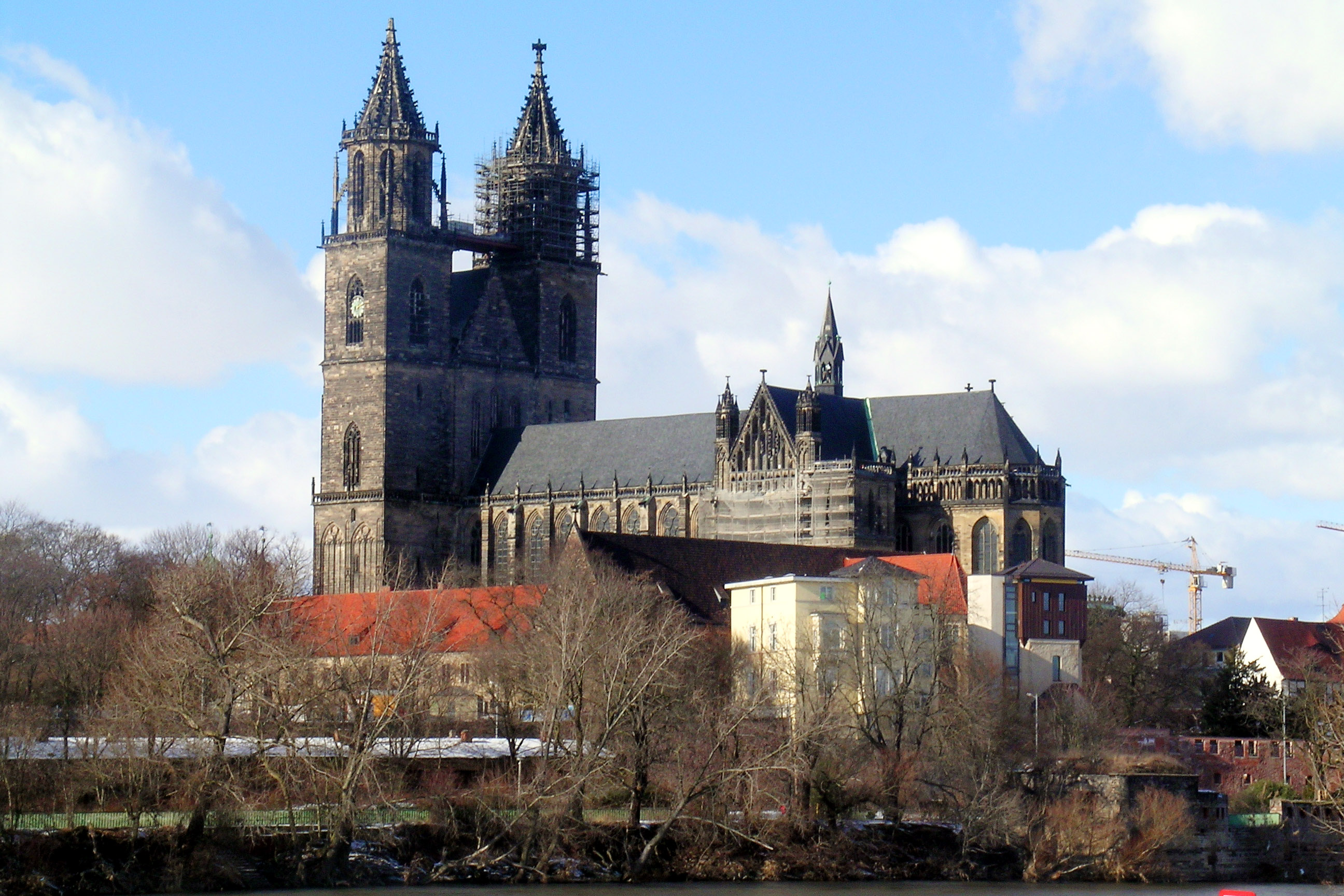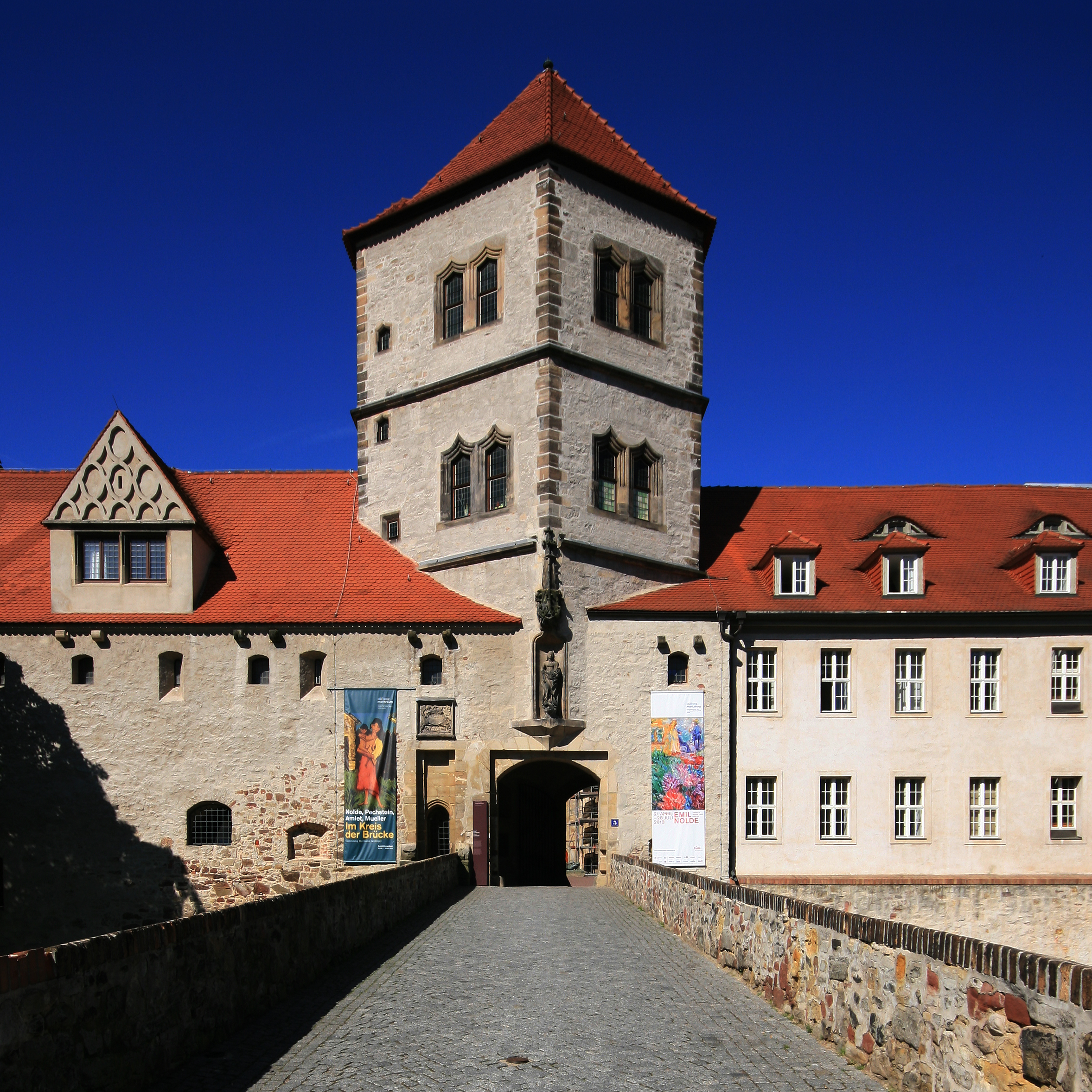|
Sigismund Of Brandenburg
Sigismund of Brandenburg (1538–1566) was Prince-Archbishop of Magdeburg and Administrator of the Prince-Bishopric of Halberstadt. Life Sigismund was born on 11 December 1538 in Cölln; the son of the Elector of Brandenburg, Joachim II (1505–1571), from his second marriage to Hedwig (1513–1572), daughter of King Sigismund I of Poland and the Hungarian Countess Barbara Zápolya. Sigismund owed not only his name, but also a close resemblance to his grandfather. Sigismund succeeded his elder brother, Frederick, in 1552 as prince-archbishop of Magdeburg and diocesan administrator of the Prince-Bishopric of Halberstadt. The administration of the Halberstadt see had been combined with the Magdeburg see since 1480. Because he was only 14 it was initially suggested that the Magdeburg Cathedral chapter could not elect him, so he was postulated. Until 1557, when he came of age, Count John George of Mansfeld was installed by the cathedral chapter to run the prince-archbishopric. ... [...More Info...] [...Related Items...] OR: [Wikipedia] [Google] [Baidu] |
Archbishopric Of Magdeburg
The Archbishopric of Magdeburg was a Roman Catholic archdiocese (969–1552) and Prince-Archbishopric (1180–1680) of the Holy Roman Empire centered on the city of Magdeburg on the Elbe River. Planned since 955 and established in 968, the Roman Catholic archdiocese had de facto turned void since 1557, when the last papally confirmed prince-archbishop, the Lutheran Sigismund of Brandenburg came of age and ascended to the see and the Magdeburg Cathedral chapter had adopted Lutheranism in 1567, with most parishioners having preceded in their conversion. All his successors were only administrators of the prince-archbishopric and Lutheran too, except the Catholic layman Leopold William of Austria (1631–1635). In ecclesiastical respect the remaining Catholics and their parishes and abbeys in the former archdiocese were put under supervision of the Archdiocese of Cologne in 1648 and under the jurisdiction of the Apostolic Vicariate of the Northern Missions in 1670. In political r ... [...More Info...] [...Related Items...] OR: [Wikipedia] [Google] [Baidu] |
Halle Upon Saale
Halle (Saale), or simply Halle (; from the 15th to the 17th century: ''Hall in Sachsen''; until the beginning of the 20th century: ''Halle an der Saale'' ; from 1965 to 1995: ''Halle/Saale'') is the largest city of the German state of Saxony-Anhalt, the fifth most populous city in the area of former East Germany after (East) Berlin, Leipzig, Dresden and Chemnitz, as well as the 31st largest city of Germany, and with around 239,000 inhabitants, it is slightly more populous than the state capital of Magdeburg. Together with Leipzig, the largest city of Saxony, Halle forms the polycentric Leipzig-Halle conurbation. Between the two cities, in Schkeuditz, lies Leipzig/Halle International Airport. The Leipzig-Halle conurbation is at the heart of the larger Central German Metropolitan Region. Halle lies in the south of Saxony-Anhalt, in the Leipzig Bay, the southernmost part of the North German Plain, on the River Saale (a tributary of the Elbe), which is the third longest river flo ... [...More Info...] [...Related Items...] OR: [Wikipedia] [Google] [Baidu] |
Archbishops Of Magdeburg
The Archbishopric of Magdeburg was a Roman Catholic archdiocese (969–1552) and Prince-Archbishopric (1180–1680) of the Holy Roman Empire centered on the city of Magdeburg on the Elbe River. Planned since 955 and established in 968, the Roman Catholic archdiocese had de facto turned void since 1557, when the last papally confirmed prince-archbishop, the Lutheran Sigismund of Brandenburg came of age and ascended to the see and the Magdeburg Cathedral chapter had adopted Lutheranism in 1567, with most parishioners having preceded in their conversion. All his successors were only administrators of the prince-archbishopric and Lutheran too, except the Catholic layman Leopold William of Austria (1631–1635). In ecclesiastical respect the remaining Catholics and their parishes and abbeys in the former archdiocese were put under supervision of the Archdiocese of Cologne in 1648 and under the jurisdiction of the Apostolic Vicariate of the Northern Missions in 1670. In political r ... [...More Info...] [...Related Items...] OR: [Wikipedia] [Google] [Baidu] |
16th-century German Roman Catholic Bishops
The 16th century begins with the Julian year 1501 ( MDI) and ends with either the Julian or the Gregorian year 1600 ( MDC) (depending on the reckoning used; the Gregorian calendar introduced a lapse of 10 days in October 1582). The 16th century is regarded by historians as the century which saw the rise of Western civilization and the Islamic gunpowder empires. The Renaissance in Italy and Europe saw the emergence of important artists, authors and scientists, and led to the foundation of important subjects which include accounting and political science. Copernicus proposed the heliocentric universe, which was met with strong resistance, and Tycho Brahe refuted the theory of celestial spheres through observational measurement of the 1572 appearance of a Milky Way supernova. These events directly challenged the long-held notion of an immutable universe supported by Ptolemy and Aristotle, and led to major revolutions in astronomy and science. Galileo Galilei became a champion o ... [...More Info...] [...Related Items...] OR: [Wikipedia] [Google] [Baidu] |
Henry Julius Of Brunswick-Wolfenbüttel
Henry may refer to: People * Henry (given name) * Henry (surname) * Henry Lau, Canadian singer and musician who performs under the mononym Henry Royalty * Portuguese royalty ** King-Cardinal Henry, King of Portugal ** Henry, Count of Portugal, Henry of Burgundy, Count of Portugal (father of Portugal's first king) ** Prince Henry the Navigator, Infante of Portugal ** Infante Henrique, Duke of Coimbra (born 1949), the sixth in line to Portuguese throne * King of Germany ** Henry the Fowler (876–936), first king of Germany * King of Scots (in name, at least) ** Henry Stuart, Lord Darnley (1545/6–1567), consort of Mary, queen of Scots ** Henry Benedict Stuart, the 'Cardinal Duke of York', brother of Bonnie Prince Charlie, who was hailed by Jacobites as Henry IX * Four kings of Castile: **Henry I of Castile **Henry II of Castile **Henry III of Castile **Henry IV of Castile * Five kings of France, spelt ''Henri'' in Modern French since the Renaissance to italianize the name ... [...More Info...] [...Related Items...] OR: [Wikipedia] [Google] [Baidu] |
Diocesan Administrator
:''See: Catholic Church hierarchy#Equivalents of diocesan bishops in law'' A diocesan administrator is a provisional ordinary of a Roman Catholic particular church. Diocesan administrators in canon law The college of consultors elects an administrator within eight days after the see is known to be vacant. The college must elect as administrator a priest or bishop at least 35 years old. If the college of consultors fails to elect a priest of the required minimum age within the time allotted, the choice of diocesan administrator passes to the metropolitan archbishop or, if the metropolitan see is vacant, to the senior by appointment of the suffragan bishops of the ecclesiastical province. If a diocese has a coadjutor bishop, the coadjutor succeeds immediately to the episcopal see upon the previous bishop's death or resignation, and there is no vacancy of the see. The see also does not become vacant if the Pope appoints an apostolic administrator. Before the election of the dioce ... [...More Info...] [...Related Items...] OR: [Wikipedia] [Google] [Baidu] |
Joachim Frederick Of Brandenburg
Joachim Frederick (27 January 1546 – 18 July 1608), of the House of Hohenzollern, was Prince-elector of the Margraviate of Brandenburg from 1598 until his death. Biography Joachim Frederick was born in Cölln to John George, Elector of Brandenburg, and Sophie of Legnica. He served as administrator of the Archbishopric of Magdeburg from 1566 to 1598, then succeeded his father as Elector of Brandenburg in 1598. Joachim Frederick was succeeded at his death by his son John Sigismund. Joachim Frederick's first marriage on 7 March 1570 was to Catherine of Brandenburg-Küstrin, daughter of John, Margrave of Brandenburg-Küstrin, and Catherine of Brunswick-Wolfenbüttel. Joachim Frederick's second marriage, on 23 October 1603, was to Eleanor of Prussia, born 21 August 1583, daughter of Albert Frederick and Marie Eleonore of Cleves. He became regent of the Duchy of Prussia in 1605. His titles also included "duke (Dux) of Stettin, Pomerania, Cassubia, Vandalorum and Crossen", acco ... [...More Info...] [...Related Items...] OR: [Wikipedia] [Google] [Baidu] |
Archdiocese Of Magdeburg
The Archbishopric of Magdeburg was a Roman Catholic archdiocese (969–1552) and Prince-Archbishopric (1180–1680) of the Holy Roman Empire centered on the city of Magdeburg on the Elbe River. Planned since 955 and established in 968, the Roman Catholic archdiocese had de facto turned void since 1557, when the last papally confirmed prince-archbishop, the Lutheran Sigismund of Brandenburg came of age and ascended to the see and the Magdeburg Cathedral chapter had adopted Lutheranism in 1567, with most parishioners having preceded in their conversion. All his successors were only administrators of the prince-archbishopric and Lutheran too, except the Catholic layman Leopold William of Austria (1631–1635). In ecclesiastical respect the remaining Catholics and their parishes and abbeys in the former archdiocese were put under supervision of the Archdiocese of Cologne in 1648 and under the jurisdiction of the Apostolic Vicariate of the Northern Missions in 1670. In political re ... [...More Info...] [...Related Items...] OR: [Wikipedia] [Google] [Baidu] |
Halle, Saxony-Anhalt
Halle (Saale), or simply Halle (; from the 15th to the 17th century: ''Hall in Sachsen''; until the beginning of the 20th century: ''Halle an der Saale'' ; from 1965 to 1995: ''Halle/Saale'') is the largest city of the German state of Saxony-Anhalt, the fifth most populous city in the area of former East Germany after (East) Berlin, Leipzig, Dresden and Chemnitz, as well as the 31st largest city of Germany, and with around 239,000 inhabitants, it is slightly more populous than the state capital of Magdeburg. Together with Leipzig, the largest city of Saxony, Halle forms the polycentric Leipzig-Halle conurbation. Between the two cities, in Schkeuditz, lies Leipzig/Halle International Airport. The Leipzig-Halle conurbation is at the heart of the larger Central German Metropolitan Region. Halle lies in the south of Saxony-Anhalt, in the Leipzig Bay, the southernmost part of the North German Plain, on the River Saale (a tributary of the Elbe), which is the third longest river flo ... [...More Info...] [...Related Items...] OR: [Wikipedia] [Google] [Baidu] |
House Of Hohenzollern
The House of Hohenzollern (, also , german: Haus Hohenzollern, , ro, Casa de Hohenzollern) is a German royal (and from 1871 to 1918, imperial) dynasty whose members were variously princes, Prince-elector, electors, kings and emperors of Hohenzollern Castle, Hohenzollern, Margraviate of Brandenburg, Brandenburg, Kingdom of Prussia, Prussia, the German Empire, and Kingdom of Romania, Romania. The family came from the area around the town of Hechingen in Swabia during the late 11th century and took their name from Hohenzollern Castle. The first ancestors of the Hohenzollerns were mentioned in 1061. The Hohenzollern family split into two branches, the Catholic Church, Catholic Swabian branch and the Protestantism, Protestant Burgraviate of Nuremberg#List of burgraves, Franconian branch,''Genealogisches Handbuch des Adels, Fürstliche Häuser'' XIX. "Haus Hohenzollern". C.A. Starke Verlag, 2011, pp. 30–33. . which ruled the Burgraviate of Nuremberg and later became the Brandenburg-P ... [...More Info...] [...Related Items...] OR: [Wikipedia] [Google] [Baidu] |
Protestant Reformation
The Reformation (alternatively named the Protestant Reformation or the European Reformation) was a major movement within Western Christianity in 16th-century Europe that posed a religious and political challenge to the Catholic Church and in particular to papal authority, arising from what were perceived to be errors, abuses, and discrepancies by the Catholic Church. The Reformation was the start of Protestantism and the split of the Western Church into Protestantism and what is now the Roman Catholic Church. It is also considered to be one of the events that signified the end of the Middle Ages and the beginning of the early modern period in Europe.Davies ''Europe'' pp. 291–293 Prior to Martin Luther, there were many earlier reform movements. Although the Reformation is usually considered to have started with the publication of the '' Ninety-five Theses'' by Martin Luther in 1517, he was not excommunicated by Pope Leo X until January 1521. The Diet of Worms of May 1521 ... [...More Info...] [...Related Items...] OR: [Wikipedia] [Google] [Baidu] |
Moritzburg (Halle)
The Moritzburg is a fortified castle in Halle (Saale), Germany. The cornerstone of what would later become the residence of the Archbishops of Magdeburg was laid in 1484; the castle was built in the style of the Early Renaissance. Since the end of the 19th century it has housed an arts museum which is recognised as being of national importance. History Origins The history of the Moritzburg is closely connected to that of Halle. In 968, when the Archbishopric of Magdeburg was established by Otto I, Holy Roman Emperor, he granted the archbishop his Giebichenstein Castle near Halle. Already in the 13th century powerful aristocrats could, by buying privileges, reduce the influence of the sovereign, the Archbishop of Magdeburg, on the town. Thus, Halle had practically reached a state of political autonomy in 1263. The same happened with Magdeburg and when the archbishops finally left Magdeburg, after a series of conflicts with the ever more powerful city council, Giebichenste ... [...More Info...] [...Related Items...] OR: [Wikipedia] [Google] [Baidu] |





.jpg)

.jpg)
